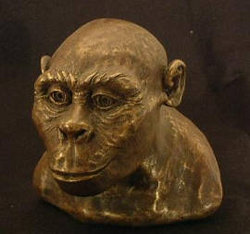Hominid
|
|
| Hominids | ||||||||||||||
|---|---|---|---|---|---|---|---|---|---|---|---|---|---|---|
 Australopithecus africanus Hominid Reconstruction | ||||||||||||||
| Scientific classification | ||||||||||||||
| ||||||||||||||
| Genera | ||||||||||||||
|
The hominids are the members of the biological family Hominidae (the great apes), which includes the extant species of humans, chimpanzees, gorillas, and orangutans, as well as many extinct species.
Originally the group was restricted to humans and their extinct relatives, with the other great apes being placed in a separate family, the Pongidae. However, that definition makes Pongidae paraphyletic, whereas most taxonomists nowadays encourage monophyletic groups. Thus many biologists consider Hominidae to include the Pongidae as the subfamily Ponginae, or restrict the latter to the orangutan and extinct relatives like Gigantopithecus. The taxonomy shown here follows the monophyletic groupings.
Especially close human relatives form a subfamily, the Homininae. Some researchers go so far as to include chimpanzees and gorillas in the genus Homo along with humans, but most genetic evidence suggests the relationships as shown here.
Many extinct hominids have been studied to help understand the relationship between modern humans and the other extant hominids. Some of the extinct members of this family include Gigantopithecus, Orrorin, Ardipithecus, Kenyanthropus, Australopithecus and Paranthropus.
The exact criteria for membership in the Homininae are not clear, but the family generally includes those species who share more than 97% of their DNA with the modern human genome, and exhibit a capacity for language and for simple cultures beyond the family or band. The theory of mind, providing the capacity to lie convincingly, is a controversial criterion distinguishing the adult human alone among the hominids. Humans acquire this capacity at about four and a half years of age, whereas the bonobo, gorilla and chimpanzee never seem to do so. However, without the ability to test whether early members of the Homininae such as australopithecines, Homo erectus, or Homo neanderthalensis had a theory of mind, it is irrational to ignore similarities seen in their living cousins. Despite an apparent lack of real culture and significant physiological differences, some say that the orangutan may also satisfy these criteria. These scientific debates take on political significance for advocates of Great Ape personhood, who some believe have influenced the debates in order to refer to "ape genocide".
In 2002, a 6-7 million year old fossil skull nicknamed "Toumaï" by its discoverers, and formally classified as Sahelanthropus tchadensis, was discovered in Chad and is possibly the earliest hominid fossil ever found. In addition to its age, Toumaï, unlike the 3-4 million year younger Australopithecine dubbed " Lucy", has a relatively flat face without the prominent snout seen on other pre-Homo hominids. Some researchers have made the suggestion that this previously unknown species may in fact be a direct ancestor of modern humans (or at least closely related to a direct ancestor). Others contend that one fossil is not enough to make such a claim because it would overturn the conclusions of over 100 years of anthropological study. A report on this finding was published in the journal Nature on July 11, 2002. While some scientists claim that it is merely the skull of a female gorilla, others have called it the most important hominid fossil since Australopithecus.
Classification
- Family Hominidae: humans and other great apes
- Subfamily Ponginae
- Genus Pongo
- Bornean Orangutan, Pongo pygmaeus
- Sumatran Orangutan, Pongo abelii
- Genus Pongo
- Subfamily Homininae
- Tribe Gorillini
- Genus Gorilla
- Western Gorilla, Gorilla gorilla
- Eastern Gorilla, Gorilla beringei
- Genus Gorilla
- Tribe Hominini
- Genus Pan
- Common Chimpanzee, Pan troglodytes
- Bonobo or Pygmy Chimpanzee, Pan paniscus
- Genus Homo
- Human, Homo sapiens
- Genus Pan
- Tribe Gorillini
- Subfamily Ponginae
See also
Template:Commonscat Template:Dichotomouskey
External links
- NPR News: Toumaï the Human Ancestor (http://www.npr.org/programs/atc/features/2002/july/toumai/index.html)
- Hominid Species (http://www.talkorigins.org/faqs/homs/species.html) at talkorigins.org
- For more details on Hominid species, including excellent photos of fossil hominids (http://www.modernhumanorigins.com/)
ast:Homínidu ca:Hominidae da:Menneskeabe (Hominidae) de:Echte Menschen es:Hominidae eo:Homedoj fr:Hominidé la:Hominidae li:Minsape nl:Hominidae ja:ヒト科 pl:Człowiekowate ru:Гоминиды sv:Människoartade zh:人科
